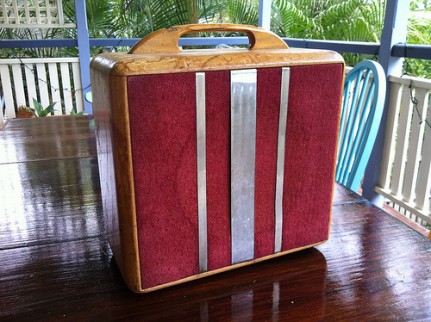1946 Fender Model 26 “Woody”

A scarily rare Fender ‘Woody’ amp… actually, probably one of the oldest Fender amps in existence.
Along with designing stuff for Tym Guitars, I also do some bits and pieces for Mark from Amwatts Amplification. My latest project is to do up a face plate for Mark’s new amp. Mark owns what is probably one of the oldest Fender amps in Australia… or anywhere else… and is in the process of making an Amwatts version. To get all the measurements correct, I dropped round to Tym’s to borrow the amp for the weekend. What a beautiful piece of design…

As a designer, how something looks is important to me. And this thing looked like a million bucks. The red velvet touches and chrome strips certainly were of the era, and give that beautiful Art Deco vibe. I asked Mark to send some info on the amp, so here you go, amp nerds:
1946 Fender Deluxe Model 26 S/N 717 is dated via speaker and pot codes to April 1946. It is a series 2 version… series ones (up to approx s/n 400) were point to point hand wired without turret boards, these were soon changed to Turret board construction, Fender was quick to incorporate the new compressed turret board material back in 1946 .
Turret Board use in guitar amps were first implemented by Fender and soon became the industry standard for amp manufacture. Another first for Fender was the amp/chassis mounted in the top of the amp with the valves hanging vertically (series 1 Model 26) or horizontally as in the series 2 Model 26. Previous amps had the chassis mounted in the bottom of the cabinets with the valves placed on top of the chassis.

It is known that these first Fender amps were designed using circuits that appeared in the Western Electric Books of the era, these circuits aren’t copied straight out of the book, W/E supplied many variations of circuits as examples to use with their valves and components sold, Leo Fender took these circuits and experimented until he had an amp design that he was happy with. Always wanting to improve his amps in both reliability and fidelity , he was constantly upgrading his the designs. So The early Fenders although based on the early circuits would not exist without Leo Fender combining the various preamp, tone stack, phase inverter, power, rectifier and output circuits to create these early amps.
Printed on the faceplate of the Model 26 is a serial number and “model 26” although it was never called that in the advertising brochures, It was always referred to as the “Deluxe” and later named the “Woody” by collectors due to it’s wooden cabinet construction.

The Cabinets were constructed from a variety of hardwoods – Maple, Walnut and Mahogany – and fitted with a colourful felt grille cloth in either – Red, Blue or Gold. The back panel of each amp was covered in the same coloured cloth as the front.

Three (occasionally two) vertical metal slats across the front protected the speaker. Walnut versions are the rarest as the wood had a bad reaction with the clear coat nitro lacquer and most examples were returned to the Factory, Fender would rehouse these amps and scrap the walnut cabs so it it unknown how many survived.

Fender never wasted any materials, It is rumoured that he ordered his packing crates from his Lap Steel timber suppliers in Maple/Walnut and Mahogany and used the wood and brackets to build these early cabs, Evidence of the crude construction is easily visible inside the cabe, with angle brackets used for holding the cab sides together and smaller brackets holding the baffle.

Leo’s cabinet designs were heavily influenced by Heywood-Wakefield furniture, which was a popular company and design in California in the late 40’s. Brochures from that era easily show the influence.

The first “Model 26” Deluxes had two 6V6 power tubes, 6SC7 preamp tube, the 6N7 driver tube, and a 5Y3 rectifier tube. The amp would have originally left the factory with all metal valves, and later with the glass version 6V6’s. The amps output is approx 10 watts.
The first series amps came out with Field Coil speakers and were quickly changed to Jensen PM10C speakers .

The amp here, Part of the “Amwatts Vintage Collection ” S/N 717 is 100% original and still working, It has all original Valves except for the output 6V6’s which have been upgraded to later 50’s glass versions. All capacitors/resistors /transformers are original , the amp gets turned on periodically to keep the electronics working , it came from the original owner who ” bought from a friend out in California just after the war named Leo” and came with an original 1946 Lap Steel guitar.

This amp was along with the other Model 26 in the Amwatts collection was sent to Mercury Magnetics to have the transformers reverse engineered, Amwatts is in the process of completely replicating the amp in every aspect, It will soon be released and will be as close to an original as you will find anywhere. They are to distributed by Tym Guitars or directly through Amwatts Amps . Standby for more

Fender custom shop did a reissue of these (think it was the 90s), but not sure how faithful to the original they are.